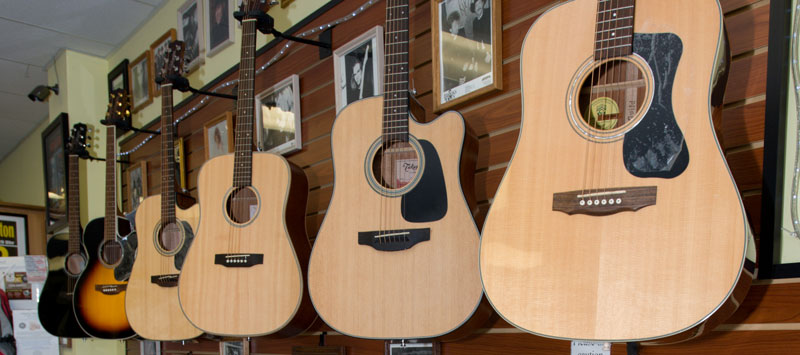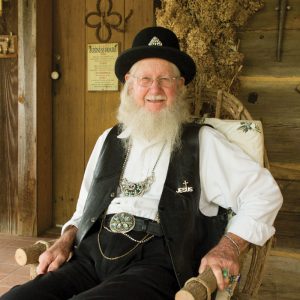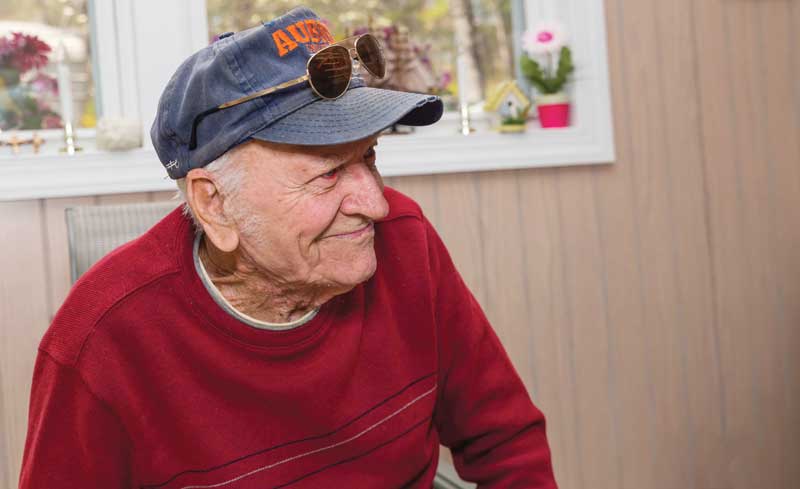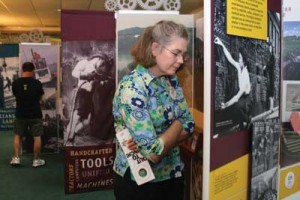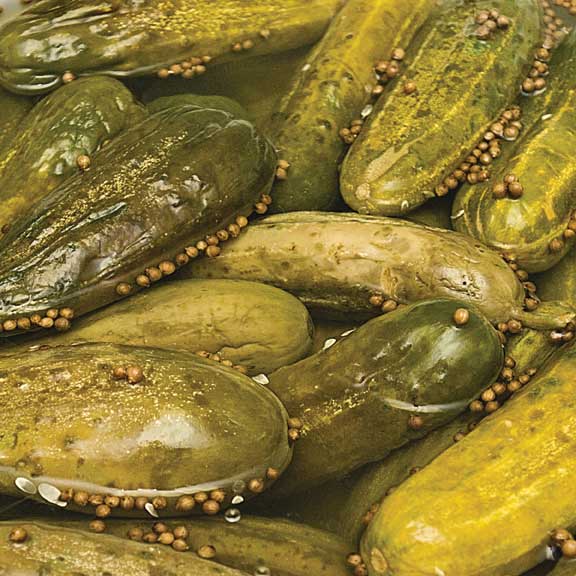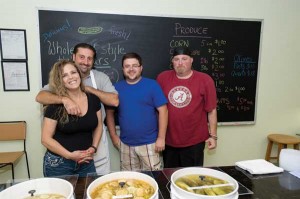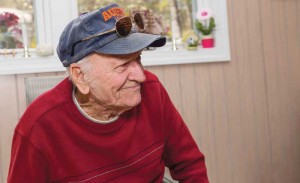 Long on inspiration
Long on inspiration
Story by Leigh Pritchett
Photos by Michael Callahan
The home of Clarence Edward Goodwin is a soft yellow, trimmed with white and cradled by blooms.
Overlooking the lake, it resembles a dollhouse.
In its entrance is a wall hanging that reads, “Within this house, may God’s love abide to bless all those who step inside.”
Goodwin sat in the bright and cheerful sunroom fashioned by his own hands. Most people know him as “Shorty” – a nickname he got in first-grade for wearing knickers. Goodwin laughed and told a visitor, “Half my grandkids don’t even know (my real name).”
Great-granddaughters Maya and Eva Webb breezed through from playing outside. Eva stopped long enough to show she had learned to twirl a baton.
It is a pleasant, peaceful existence.
Yet, it is far, far removed from the daily horrors Goodwin faced 70 years ago as a prisoner of war.
Born in Walker County, Goodwin, who is 90, grew up in the Pinson-Chalkville area.
When he was drafted at 18, the United States was involved in World War II. After finishing Army basic training in Texas, Goodwin boarded a train for Virginia, where he would be deployed overseas. On the way, he became ill and was hospitalized in Pennsylvania.
Upon his release, records declaring him dead went to Washington, D.C., while the very much alive Goodwin was sent to Virginia. From there, he went first to North Africa, then Italy.
Because he was “deceased,” his two basic training paychecks would be his entire monetary compensation for three years of military service.
Attached to the 36th Texas Division, 142nd Infantry, he and four others were positioned at a river in the region of Naples, Italy, with the charge of preventing the Germans from advancing.
“There was a river in front of us. (German) tanks came across it like it was a roadway,” Goodwin recounted. “We ran out of ammunition and everything else. We had no choice” but to surrender.
Goodwin’s captors marched him 350 miles and put him into a boxcar with so many other people that they could only stand up. Goodwin was taken to Munich, Germany, and made to walk into Poland. He ended up in a POW camp working 12-hour days. At night, the captives were locked up and their shoes confiscated.
That was in 1943.
From then until late summer 1945, he would spend time in at least four different stalags in Germany, as well as work camps in Poland. He would turn 19 and 20 in captivity.
With his own eyes, he saw unspeakable atrocities: Women raped and the men who tried to defend them being strung up on street lamps until they died; people shot at point blank as they fell on their knees, crying for mercy; ashes falling from the sky like snow — ashes from incinerated bodies.
He was made to remove the bodies of starvation victims at the Dachau concentration camp.
He saw Jewish people who were so thin that they were skeletons. Yet, it was an accident that he should see them and the corpses. Because he is an American, he was quickly removed from the task. “The Germans didn’t want the Americans to know that was happening,” he said.
He knows the Holocaust was real. Even so, his mind could not comprehend the evil. “How can this be happening?” he wondered. “What’s next?”
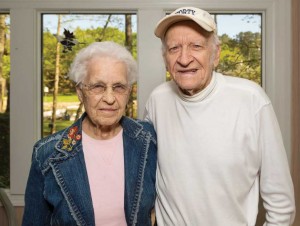 Those two words – “what’s next?” – described life day after day during captivity.
Those two words – “what’s next?” – described life day after day during captivity.
There was little, if any, food for the POWs. They would scratch in the dirt to find worms, insects, grass – anything to eat.
“There were a number (of POWs) who just willed themselves to death,” recalled Goodwin. “They just didn’t want to live.”
The winters were long and the cold penetrating. “It’ll get to you in a hurry,” Goodwin said.
The prisoners had only pants and shirts. There were no coats, no glass in the windows, no heat in the buildings. The captives huddled together for warmth.
Torture was frequent and heinous.
Once, Goodwin was put in an underground pit that was too small for him to sit or stand. He had seen other men emerge from this punishment, stripped of their sanity by the relentless darkness, silence and solitude.
He resolved to remain sane.
He would play ballgames in his head, adding extra innings as needed. He would think about his mother, Katie Goodwin, and replay in his mind the different steps it took for her to prepare a meal or attend to her chores.
“That’s how I kept my mind occupied,” Goodwin said.
He had no idea how much time passed while he was in the pit, but later learned it was 15 days.
During the months and years of captivity, thoughts of his mother were ever present with him. Many are the times he asked God to give him the chance to hug her once more.
Four times, Goodwin tried to escape from camps. Each time, soldiers, dogs or Hitler Youth caught him.
The fifth attempt was vastly different.
Using a yardstick he found somewhere, Goodwin started measuring all sorts of objects in the camp. “Cassidy” – a man whom Goodwin took into his confidence for this mission – wrote down the figures Goodwin would tell him.
The pair measured and measured for weeks. This activity became so common that the guards apparently began to see it as harmless.
At one point, Goodwin was even allowed to measure the barrel of the gun a German guard was holding.
The duo measured around a guard building. Goodwin discovered that, when he was behind the building, the guard could not see him or the train station about 300 feet away.
One day when they were measuring around the building, Goodwin told Cassidy to run for the train when its whistle blew.
The whistle sounded; the two sprinted.
As they approached the back of the train, a German officer at the rear of the last car urged them in his language to hurry. He stretched out his hand to help Goodwin onto the train, and Goodwin thanked him in German.
Before long, Goodwin and Cassidy came to the sinking realization that the train was headed into – not out of – Germany. They knew they had to get off, so they jumped through the train windows. Goodwin landed on a river embankment and swam away, with bullets flying past him. But Cassidy collided with a metal bridge and died instantly.
For three weeks, Goodwin hid in the daytime and traveled at night. He sought Russian troops, knowing they were the only ones in the region working with the Allies.
When he came upon the Russians, they were not pleased to see him, their sentiments toward the Americans having soured over issues. In fact, they wanted to send Goodwin to Siberia.
Somehow, though, Goodwin convinced an officer that he wanted to fight alongside the Russians soldiers. For three weeks, he did.
When the Russians finally met up with American troops in Berlin, Goodwin was able to rejoin his countrymen. He said to a Russian officer, “Let’s go home. The war’s over.”
The officer replied, “For you, yes. For me, never.” Then, the officer pulled a star pin from his lapel and gave it to Goodwin, asking him to remember.
Goodwin keeps the pin in a shadow box, which contains the tangible reminders of his service to his country. There are medals for marksmanship, expert rifleman, North Africa campaign, German occupation, good conduct and World War II. His POW ribbon was sent to him 42 years after the fact during President Reagan’s Administration. His favorite, though, is the medal for gallantry.
Tears stream down Goodwin’s face as he retells what happened on the battlefield and in the POW camps. Tears come when he speaks of asking God to let him hug his mother again. They come as he talks about how God’s hand was upon him during captivity.
He thinks back to the moment when his hands were raised in surrender. Goodwin realized then that he was a man without a country, a flag, a family or friends. He was alone.
It was then that he clearly heard the voice of God saying, “But I’m with you.”
“A peace came over me,” Goodwin said. “I can’t explain it.”
The peace was present the entire time he was a POW. “It’s still there,” Goodwin said.
Surrounded by ‘angels’
Many were the times that his life was spared or that people came into his path to help him. He is certain God put angels around him to protect him.
One instance during which Goodwin felt that protection was when he stood before a firing squad. The soldier giving the commands shouted, “Ready … aim …”
The word “fire” was all that stood between Goodwin and death.
But rather than utter that final word, the soldier gave Goodwin the chance to go back to work.
Another time was during a torturous interrogation. His German interrogator suddenly stated in English to other German soldiers in the room, “He’s a Christian. Let him go.”
Still another act of divine intervention was when Goodwin experienced appendicitis. A Russian medic happened to be in the same camp as Goodwin. Even though he could not speak English, the medic indicated that he could do the surgery.
The operating room was a stall from which a cow had to be removed, the scalpel a sharpened piece of metal. The string of a nearby feedbag was used for sutures. The only infection control was the 20-degree temperature outside.
There was no anesthesia. Goodwin just passed out at some point during the surgery. When Goodwin awoke, he was alone in the barn. The Russian was gone. In fact, he never saw the Russian again.
“I can see nothing but (God’s) hand in my life,” Goodwin said.
After Goodwin’s escape from captivity, it took a month for him to return by ship to the United States. From New York, he went by train to Birmingham, arriving at 1:30 one morning.
With no other means for getting home, he decided to walk. He figured he had walked over much of Europe as a POW, so he could certainly walk the 22 miles from Birmingham to Pinson.
Goodwin did not know at the time the cloud of uncertainty under which his parents had been living. His parents first had received a telegram, saying their son was killed in action. Later, a Tarrant woman told them she had heard a BBC broadcast that her own son and Goodwin were taken prisoner.
The Goodwins did not know which was the truth.
At 7 a.m., Goodwin reached home.
“That was when I put my arms around my mom that I’d been praying for so long,” Goodwin said. “She fainted.”
After he was discharged from the military, Goodwin had only a week to recuperate before returning to semi-professional baseball.
In a tournament during which he played for the Continental Gin team, he hit a home run and two triples. A scout saw him and Goodwin soon signed to play with the Rome Colonels in South Carolina, a farm team of the Detroit Tigers.
After a year, he decided to go back to semi-pro baseball. In 1953, his team missed winning the World Series in Battle Creek, Mich., by one game.
He played semi-pro until he was 62 years old.
In 1947, he wed his wife Joyce, better known as “Bitt.” They now are in their 66th year of marriage, a union blessed with three children, eight grandchildren and six great-grandchildren.
Through the years, he has been an aircraft electrical mechanic, a plumber and an appliance repairman with his own shop. “I haven’t quit that yet,” he said. “I won’t ever retire, I don’t guess.”
However, his POW experiences he kept to himself. He did not even tell his dad, Carlton Goodwin, before his death in 1976.
After moving to Pell City in 1982, Goodwin felt like God was telling him to share his story. The first time he told it was at his church, First Baptist in Pell City.
Since, he has spoken to many thousands in schools, churches and other groups in Alabama and during a television interview. He has shared his story about being a POW and about the peace he has through salvation in Jesus Christ, God’s Son.
As a result of his sharing, two professionals at Veterans Administration Hospital in Birmingham told Goodwin they wanted to experience the peace he has in his life. And they received it when they asked Jesus to come into their heart and be their Savior, he said.
Goodwin now believes God allowed him to go through the POW experience so he can minister to others. If it helps someone else, if it leads someone to salvation in Jesus, then the years in captivity were worth the cost, he said.
One thing he has come to understand is the importance of not dwelling on the bad that happens in life. Harboring those thoughts robs a person of joy.
He also said he does not worry about tomorrow or next month or next year. Instead, he lives minute to minute.
“The moment is all that we have,” he said. “I’m only assured of the moment. I’m here at the mercy of the Lord every day, every moment, every breath. When I finish my mission, He’ll call me.”




































